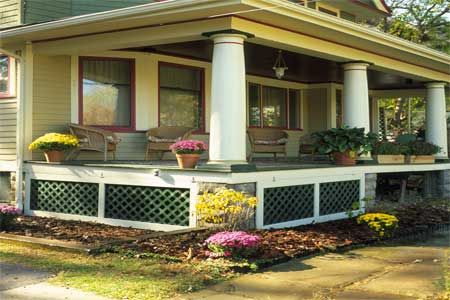Installing lattice under your deck can upgrade your home’s exterior while offering practical benefits such as storage and pest control. In one weekend, you can DIY a polished and professional-looking trim around your home. This comprehensive guide will walk you through how to add this decorative and functional feature to your outdoor space and customize it to match your home’s style.
Understanding Deck Lattice
Deck lattice serves many purposes beyond enhancing your home’s appearance. It can conceal and protect your home’s understructure while letting air flow through it, which helps prevent moisture buildup and potential rot in the framing. Deck lattice can also deter animals from nesting under your deck and provide easy access for structural or system maintenance and storage.
Types of Deck Lattice Materials
You can use many different materials for deck latticework and each one offers unique benefits. Some of the most common deck lattice materials include the following:
- Composite: Composite lattice combines the look of wood with the durability of synthetic materials. It’s popular with homeowners who prefer low-maintenance materials.
- Metal: Metal lattice is typically powder-coated to resist rust and can withstand harsh weather conditions better than other materials.
- PVC: PVC lattice is another lightweight, low-maintenance option that resists weathering, peeling, splitting, and fading.
- Vinyl: Vinyl lattice is resistant to rot and insect damage. It’s also lightweight, making it easier to handle and install.
- Wood: Wood lattice provides a classic look and you can paint or stain it to match your deck, but it needs regular upkeep to protect against decay.
Tools and Materials for a Deck Lattice
You’ll need the following tools and materials to install your porch lattice:
- Drill/driver
- Dust mask
- Hinges (if creating access panels)
- Lattice panels
- Level
- Measuring tape
- Paint or stain (if desired)
- Pencil for marking
- Pressure-treated lumber for framing
- Safety gear (gloves and safety glasses)
- Saw (circular or saber)
- Screws and washers
- Work gloves
Keep extra paint or stain on hand for touch-ups if any pieces sustain scratches during installation. Ensure all tools are functional to avoid potential issues or accidents.
How To Install Lattice Under Deck
Once you’ve chosen your lattice material and gathered the necessary tools, follow our step-by-step guide to install your deck lattice. Take your time and pay close attention to your work to avoid damaging your home or the material.
1. Prep for Installation
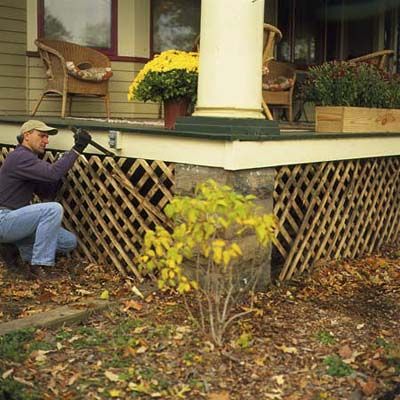
Remove Old Lattice and Debris
- Remove any old lattice from your porch using a flat pry bar. Avoid damaging the porch fascia or support columns as you do this.
- Measure the openings between the columns or posts. The completed frames must be 1/2 inch narrower than the overall width and 1 inch shorter than the height to allow for proper fitting.
- Clear the area beneath your deck of debris and vegetation and level it if necessary.
- Check the deck’s support structure for any issues and address them before installing the new lattice.
Choose Your Lattice Design
Select a lattice design that complements your home’s architecture and your personal preference. Options range from traditional diamond patterns to more modern horizontal or vertical slats. You can also use the spacing as a design element—tighter spacing offers more privacy, while wider spacing allows for better airflow. Decide whether you will paint or stain the lattice before or after installation as this can affect its overall look and lifespan.
2. Begin Assembly
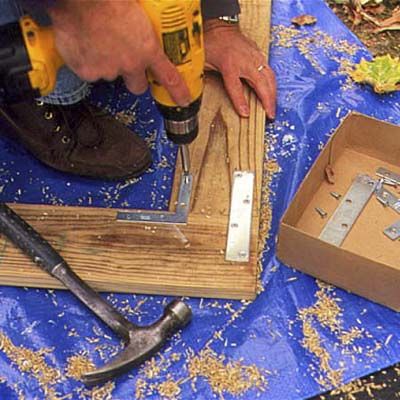
- Cut the frame parts to length and assemble them face down on a flat surface.
- Install a 6-inch mending plate and a 3 1/2-inch flat corner brace at each corner joint to strengthen the frame.
- Position the hardware pieces about 1/4 inch from the edge of the frame and secure them with 3/4-inch-long flathead screws.
Tip: Double-check your measurements before making any cuts to create a professional-looking finish and avoid wasting materials. For added support, you can use longer screws or additional braces if your lattice will cover a larger area.
3. Connect the Center Stile, Prime, and Paint
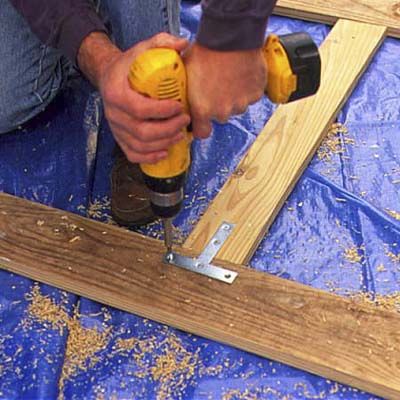
- Connect the center stile to the frame using two 4-inch T-plates. Make sure to center the leg of the T-shaped plate on the 1×4 stile.
- Once you’ve assembled the frames, apply a coat of primer followed by two coats of gloss enamel trim paint to protect them from moisture.
- Allow each coat to dry completely before applying the next one.
- Paint or stain the lattice before attaching it to cover and protect all sides of the wood.
You can skip this step for composite or vinyl lattice, but we recommend you clean the panels before you install them.
4. Size the Lattice Panels
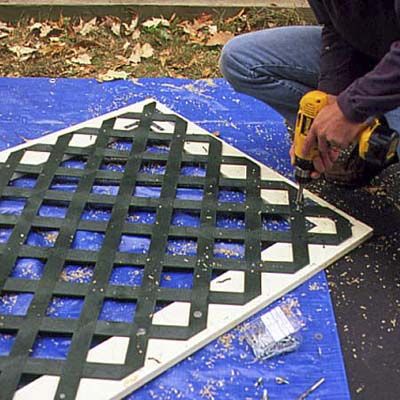
Cut the lattice panels to size using a saber or circular saw as follows:
- Lay the frames face down and attach the lattice with 1-inch panhead screws driven through washers.
- Drill clearance holes that are slightly larger than the screw shanks so the lattice can expand and contract with temperature changes.
If you’re using vinyl or composite lattice, use a fine-toothed blade to prevent chipping or cracking.
Tip: Take multiple measurements before cutting the panels to make sure they fit correctly. Use clamps to hold the lattice steady while you work to minimize shifting.
5. Secure the Seam
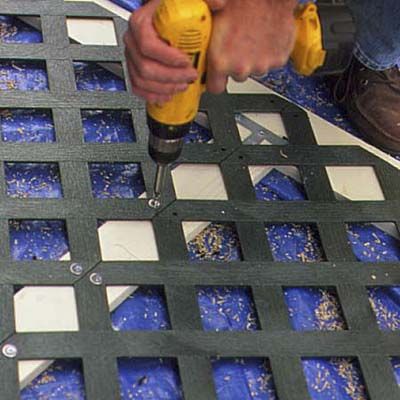
- Where two pieces of vinyl lattice meet at a center stile, secure the seam with two rows of 1-inch panhead screws.
- Take care not to overtighten the screws as this can cause the lattice to warp or crack. The goal is to secure the lattice firmly while allowing for natural expansion and contraction.
- Check the alignment frequently as you work to keep the panels straight. If necessary, use a level to double-check the lattice’s position as you secure the pieces together.
6. Hang the Framed Lattice Panels
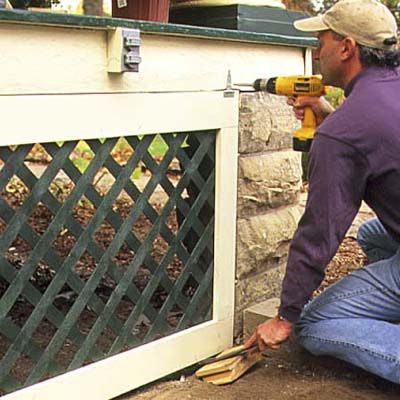
Hang the framed lattice panels from the porch using either 3- or 4-inch T- or strap hinges. Two hinges are sufficient for panels shorter than 8 feet, but use three hinges on longer ones to distribute the weight evenly and prevent sagging. Here’s how to hang the panels:
- Screw the hinges to the frames.
- Set the panels in the openings under the porch.
- Use a pry bar to raise the panel tightly against the porch fascia.
- Use a drill/driver to screw the hinge to the porch.
- Check to make sure the panel swings up and down smoothly. If it drags on the ground, use a shovel or rake to remove some dirt from in front of the panel.
- If there’s a large gap beneath the panel, add soil and smooth it out to level the ground. Maintain the proper clearance to prevent wear and tear on the panel and ground.
Lattice: Finishing Touches and Maintenance
After installing your lattice, take these final steps to keep it protected and functional for years:
Add Decorative Elements
Consider adding trim pieces around the edges of your lattice panels for a more finished look—and consider painting them in a contrasting color to highlight the design and add a unique element to your deck’s appearance. You can also incorporate planters or climbing plants to enhance your deck lattice’s visual appeal. For an elegant touch, add decorative caps or finials to the posts.
Tips for Long-Term Lattice Care
To maintain your lattice over time, consider the following tips:
- Apply a water-repellent sealer to the wood lattice every few years.
- Check for loose screws or damaged sections annually.
- Identify and repair any damage or problems immediately to avoid further issues.
- Inspect the hinges and frames regularly and oil hinges as needed.
- Regularly clean your lattice with a soft brush and mild soap solution.
- Remove any buildup behind the lattice to prevent moisture damage.
- Repaint or restain any wood lattice every two to three years.
- Trim any vines or plants growing on your lattice to prevent overgrowth.
Upgrade Your Lattice Installation
Here are some creative ways to turn your plain lattice into a stylish accent that beautifies your home’s foundation:
- Install a small access door within the lattice so you can easily reach the area under your deck.
- Install landscape lighting around the lattice to create a warm atmosphere in the evening.
- Install solar lights to improve safety and visibility at night, making your outdoor space more usable after dark.
- Paint or stain your lattice in a complementary color to your home’s exterior.
- Use the space behind the lattice to discreetly store garden tools or seasonal items.
